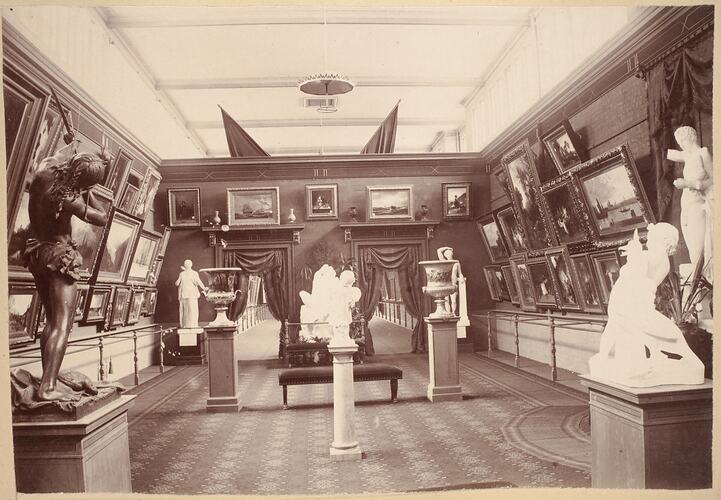Summary
View of the German Fine Art Gallery display on the southern wall of the western nave in the Great Hall at the 1880 Melbourne International Exhibition held at the Exhibition Buildings, Carlton Gardens, between 1 October 1880 and 30 April 1881.
The picture galleries of the various countries were situated on the first floor balconies of the main Exhibition Building. The German Picture Court was next to those of Holland, Belgium and the United States, on the southern wall of the Building, and differed from the art gallery displays of other countries such as France, Italy, and Great Britain, and the colony of Victoria, which had their picture galleries directly above their ground level courts in the Great Hall. Due to the floor space required for the British paintings, which also consumed some of western wall in the northern transept, originally held for Victorian art, German paintings and decorative arts were located at the opposite end of the Hall to the German Courts immediate to the right of the main eastern entrance.
Germany exhibited almost 100 oil paintings, the majority of which had been shown the previous year during the 1879 Sydney International Exhibition. At the far end of the gallery space, situated between the two doorways into the gallery, can be seen a copy of the well-known classical sculptural figure, commonly known as the Barberini Faun or the 'Drunken Satyr'. The original of this Hellenistic piece of marble work is now held in the Glyptothek, Munich. Several large Meissen porcelain vases also adorned the German gallery, two of them visible atop pedestals towards the end of the gallery space.
This is one of seventy-six photographs in a photograph album. Twenty-six photographs are of the 1880 Melbourne International Exhibition. The photographs provide us with important visual evidence about the gardens around the Exhibition Building, and interior exhibits, including detailed images of the British Art Court, the ceramic and pottery exhibits in the Main Hall, and the appearance of the Avenue of Nations. The photographs are taken from glass plates and retain an excellent level of clarity and detail.
The album also contains a number of photographs in the 'Frith's Series', taken by British photographer Francis Frith, or members of his staff, of Gibraltar, and villages and towns in Britain.
Description of Content
International Exhibition, Melbourne, 1880. Interior view of the Exhibition Building showing the German Fine Arts Gallery in the southern balcony of the western nave in the Great Hall.
Physical Description
Albumen photograph mounted on buff-coloured card in red, cloth-covered, photograph album with decorative gold tooled border and gold tooled lettering in centre of front cover.
Significance
Part of photograph album containing a number of previously-unknown images documenting displays in the 1880 Melbourne International Exhibition in the Exhibition Building.
The images give visual evidence about the products displayed, the display techniques used, and the interior and exterior of the Exhibition Building in 1880, and as such, are a valuable addition to the collection of graphic and other material relating to the history of the Royal Exhibition Building.
The Melbourne International Exhibition of 1880 was the first event held in the new Exhibition Building. It showcased recent inventions, art and design trends to the Melbourne public, and allowed Victorians to promote themselves and their industry and achievements to a national and international audience. The exhibition attracted over a million visitors, and ran for several months. Its long-term results were changes in Melburnian's domestic tastes, increased trading opportunities with Europe, and a growth in Australian pride and national feeling.
See 'Notes' for information about the names of possible photographers who may have taken these images.
The album also contains a number of photographs in the 'Frith's Series', taken by British photographer Francis Frith (1822 - 1898) or members of his staff, of Gibraltar, and villages and towns in Britain. There are also large-format images and are of value for the Museum's 'History of Photography' collection. It appears as if Frith did not visit Australia; and the photographs of the Exhibition do not bear any signature from his company.
More Information
-
Collection Names
-
Collecting Areas
Images & Image Making, Public Life & Institutions, Royal Exhibition Building
-
Acquisition Information
Purchase
-
Place & Date Depicted
Royal Exhibition Building (REB), 1 Nicholson Street, Melbourne, Greater Melbourne, Victoria, Australia, 1880
-
Format
Photograph, Monochrome
-
Inscriptions
Written inside the front cover of album: 'W.W.Scott/ c/o Horticultural Press/ 78A Victoria Street/ Melbourne C1/ Box 1944/ Phone F2656/ [illegible]; Sold by G.W.Harris, Donolly Victoria.'
-
Classification
Public events, Melbourne international exhibition 1880, Photograph albums
-
Category
-
Discipline
-
Type of item
-
Image Dimensions - Photograph
188 mm (Width), 135 mm (Height)
Dimensions of photograph only
-
Image Dimensions - Photograph
280 mm (Width), 360 mm (Height)
Overall dimensions of album [portrait orientation]
-
References
'The Germany Gallery', South Australian Register, Mon., 25 October 1880, p.5. 'The Picture Galleries. Art in Germany', Argus Exhibition Supplement, Fri., 15 October 1880, p.28.
-
Keywords
Art, Art Exhibitions, Buildings, Civic Mementoes, Exhibitions, Exhibitions: Melbourne International, 1880-1881, Exterior Views, Gardens, Keepsakes, Museum Galleries, Photography, Public Ceremonies, Royal Exhibition Building

